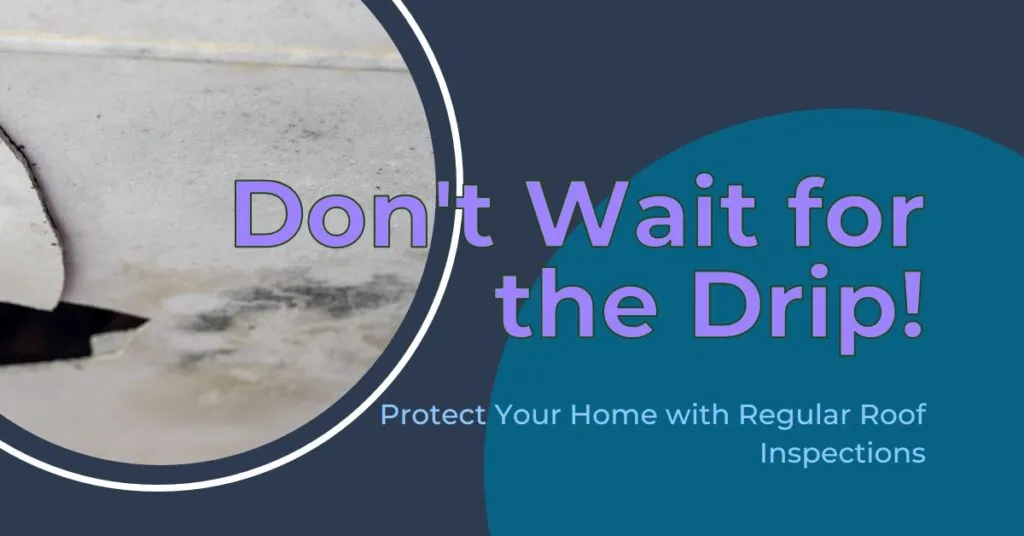The visibility of a roof leak varies based on factors like the leak’s size and the roof’s insulation, but typically, minor leaks might take months to show signs.

Immediate indicators may include musty odors or dark spots in the attic, while more evident signs, like ceiling stains, might appear later.
Roof leaks are among the silent but significant threats homeowners face. Often subtle, these leaks might not be immediately noticeable, but their effects can be profoundly damaging over time.
The emphasis here is on the necessity of early detection, as it can save money and the structural integrity of one’s home.
The Onset of Roof Leaks
Roof leaks don’t just appear overnight. Their common causes include damaged shingles, issues with flashing, and clogged gutters, among others.
What’s crucial is to understand the difference between when a leak starts and its symptoms become visible.
A leak might have been initiated months before any discernible signs appeared.
Factors Influencing Leak Visibility
Roof leaks can be stealthy adversaries, often hiding their presence until significant damage is done. But why do some leaks make their presence known immediately while others lurk in the shadows for weeks or even months?
To understand this, we must delve deeper into the factors that influence the visibility of these leaks.
Size of the Leak:
It’s a straightforward principle: the larger the breach, the faster you’ll notice it. Large leaks, often resulting from storm damage or significant wear, can lead to immediately apparent issues like water stains or even dripping.
On the other hand, more minor leaks, perhaps caused by a missing nail or little crack, might only manifest subtle hints of their existence, requiring a keen eye to detect.
Roof Insulation:
Insulation isn’t just about keeping your home warm in winter and cool in summer. It’s also an unsung hero when it comes to managing roof leaks.
A well-insulated roof can act as a sponge, soaking up the intruding water and preventing it from immediately seeping into the living spaces below.
However, while this might sound like a boon, it’s a double-edged sword. While the insulation might delay the visibility of the leak, it can also mask the problem until significant damage occurs.
Roof Underlayment:
The underlayment is a silent guardian tucked away beneath your primary roofing material. This layer, often made of felt or synthetic materials, is a secondary defense against water penetration.
Even if water breaches the outer roofing material, a robust underlayment can halt its progress, ensuring the home’s interior remains dry.
However, like insulation, a successful underlayment might delay the appearance of a leak, emphasizing the importance of regular roof checks.
Attic Space:
Attics aren’t just storage spaces for old memories; they are vital to roof health. A spacious, well-ventilated attic can effectively dissipate moisture, reducing the chances of leaks manifesting below.
However, if the attic space is neglected, dampness can accumulate, leading to mold growth and wood rot. This, in turn, can mask the signs of a leak until the damage becomes severe.
While these factors can delay the appearance of leaks, they also underscore the importance of regular inspections and maintenance. After all, in the realm of roofing, what you don’t see can indeed hurt you.
Indications of a Hidden Roof Leak
Sometimes, leaks might not be immediately visible but show indirect signs. Homes might have musty odors in certain rooms, or one might notice dark spots on attic insulation.
Mold growth, especially in attics, is a significant red flag. And then, there are those times when the sound of dripping water gives away a hidden leak, even if you can’t see the moisture.
How Long It Usually Takes For Roof Leaks to Show
The time frame for leaks to show varies. Small leaks, especially in homes with good insulation and underlayment, might take months to become evident.
But why do some leaks take longer than others? The reasons are numerous and closely tied to the factors listed above.
However, waiting for visible signs can be perilous, leading to more extensive damage.
The Consequences of Ignoring a Roof Leak
Overlooking a roof leak is a costly mistake. Over time, consistent moisture can cause structural damage.
This moisture also creates a favorable environment for mold and mildew, threatening the health of the home’s occupants.
Furthermore, untreated leaks diminish property value and, in the long run, result in higher repair costs.
Proactive Measures
In order to avoid issues with roof leaks, consistent inspections are vital. Acting swiftly at the initial signs of a leak, such as a stain or a musty smell, is crucial.
Additionally, routine expert evaluations can pinpoint weaknesses, helping address minor concerns before they become significant.
The Imperative of Timely Roof Maintenance
In the realm of home maintenance, addressing roof leaks promptly is both a protective and cost-saving measure.
Early detection and timely repair safeguard the home’s structural integrity and protect its value, emphasizing the adage – a stitch in time saves nine.
